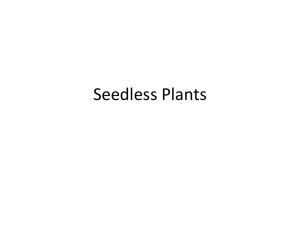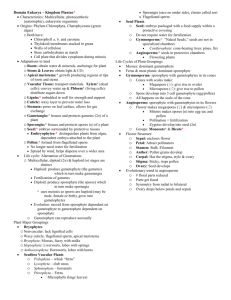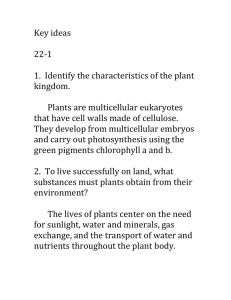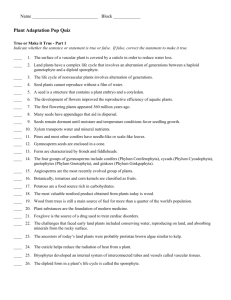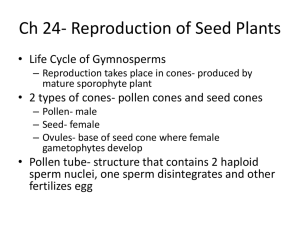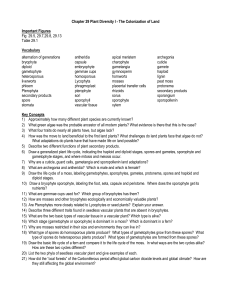Nerve activates contraction
advertisement
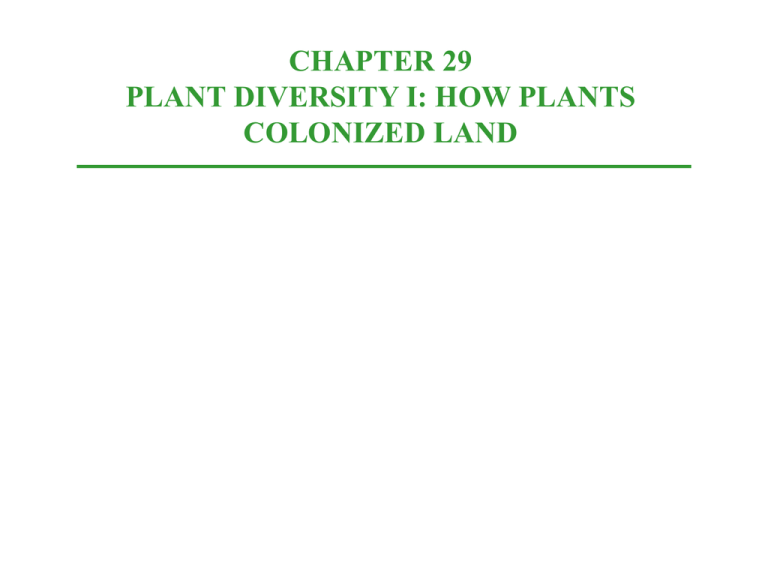
CHAPTER 29 PLANT DIVERSITY I: HOW PLANTS COLONIZED LAND An Overview of Land Plant Evolution • More than 280,000 species of plants inhabit Earth today. • Land plants evolved from a green algae, called charophyceans. Evolutionary adaptations to terrestrial living characterize the four main groups of land plants • There are four main groups of land plants: bryophytes, pteridophytes, gymnosperms, and angiosperms. • Bryophytes, pteridiophytes, gymnosperms, ands angiosperms demonstrate four great episodes in the evolution of land plants: • the origin of bryophytes from algal ancestors • the origin and diversification of vascular plants • the origin of seeds • the evolution of flowers Charophyceans are the green algae most closely related to land plants • The plasma membranes have a particular cellulose structure of the cell wall. • The presence of peroxisomes. • Enzymes in peroxisomes help minimize the loss of organic products due to photorespiration. • Land plants that have flagellated sperm cells which are similar to charophyceans. Several terrestrial adaptations distinguish land plants from charophycean algae • apical meristems • multicellular embryos dependent on the parent plant • alternation of generations • sporangia that produce walled spores • gametangia that produce gametes • Apical meristems, localized regions of cell division at the tips of shoots and roots. • Alternation of generations • Gametophyte- haploid cells, produces: gametes (egg and sperm.) • Sporophyte- diploid cells, produces: haploid spores. • A spore is a reproductive cell that can develop into a new organism without fusing with another cell. • Sporangia- are found on the sporophyte and haploid produce spores by meiosis. • Spores are covered by a polymer called sporopollenin, the most durable organic material known. • Gametangia- produces gametes • Archegonium- a female gametangium, produces a single egg cell in a vase-shaped organ. Antheridia- a male gametangia, produces many sperm cells that are released to the environment. • Cuticle- covers leaves with polyesters and waxes. • protects the plant from microbial attack. • waterproofing to prevent excessive water loss. • Stomata- pores in the epidermis of leaves allow the exchange of carbon dioxide and oxygen between the outside air and the leaf interior. • Xylem- Tube-shaped cells carry water and minerals up from roots. Cells are dead. • Phloem- is a living tissue in which nutrientconducting cells arranged into tubes distribute sugars, amino acids, and other organic products. The Origin of Land Plants Land plants evolved from charophycean algae over 500 million years ago • The oldest known traces of land plants are found in mid-Cambrian rocks from about 550 million years ago. Bryophytes- The three phyla of bryophytes are mosses, liverworts, and hornworts • Bryophytes are represented by three phyla: • phylum Hepatophyta - liverworts • phylum Anthocerophyta - hornworts • phylum Bryophyta - mosses The gametophyte is the dominant generation in the life cycles of bryophytes • Sporophytes are smaller and present only part of the time. • Gametophoresgenerate gametes • Bryophytes are anchored by tubular cells or filaments of cells, called rhizoids. • not composed of tissues • lack specialized conducting cells • do not play a primary role in water and mineral absorption. • The gametophytes of hornworts and some liverworts are flattened and grow close to the ground. Bryophyte sporophytes disperse enormous numbers of spores Bryophytes provide many ecological and economic benefits • Wet regions dominated by Sphagnum or peat moss are known as peat bogs. • Carbon reservoirs- stabilizes atmospheric carbon dioxide levels. • Used in the past as diapers and a natural antiseptic material for wounds. A diversity of vascular plants evolved over 400 million years ago • Cooksonia, an extinct plant over 400 million years old, is the earliest known vascular plant. Pteridophytes: Seedless Vascular Plants • phylum Lycophyta - lycophytes • phylum Pterophyta - ferns, whisk ferns, and horsetails A sporophyte-dominant life cycle evolved in seedless vascular plants • The leafy fern plants are sporophytes. • The gametophytes are tiny plants that grow on or just below the soil surface. A homosporous sporophyte produces a single type of spore. • A heterosporous sporophyte produces two kinds of spores. • Megaspores develop into females gametophytes. • Microspores develop into male gametophytes. Lycophyta and Pterophyta are the two phyla of modern seedless vascular plants • Phylum Lycophyta - Modern lycophytes are relicts of a far more eminent past. • By the Carboniferous period, lycophytes existed as either small, herbaceous plants or as giant woody trees with diameters of over 2m and heights over 40m. • The giant lycophytes thrived in warm, moist swamps, but became extinct when the climate became cooler and drier. • The smaller lycophytes survived and are represented by about 1,000 species today. • The phylum Pterophyta: • Psilophytes, the whisk ferns • Sphenophytes are commonly called horsetails because of their often brushy appearance. • Ferns first appeared in the Devonian and have radiated extensively until there are over 12,000 species today. • Ferns produce clusters of sporangia, called sori, on the back of green leaves (sporophylls) or on special, non-green leaves. Overview of Seed Plant Evolution (1) the evolution of seeds, which lead to the gymnosperms and angiosperms, the plants that dominate most modern landscapes (2) the emergence of the importance of seed plants to animals, specifically to humans. Agriculture, the cultivation and harvest of plants (primarily seed plants), began approximately 10,000 years ago in Asia, Europe, and the Americas. • Seed plants are vascular plants that produce seeds. • Important reproductive adaptations: • continued reduction of the gametophyte • the advent of the seed • the evolution of pollen. 1. Reduction of the gametophyte continued with the evolution of seed plants • The gametophytes of seed plants are even more reduced than those of seedless vascular plants. 2. Seeds became an important means of dispersing offspring • A seed consists of a sporophyte embryo packaged along with a food supply within a protective coat. • All seed plants are heterosporous, producing two different types of sporangia that produce two types of spores (megaspores and microspores). • Layers of sporophyte tissues, integuments, envelop and protect the megasporangium. • An ovule consists of integuments, megaspore, and megasporangium. 3. Pollen eliminated the liquid-water requirement for fertilization • They are carried away by wind or animals until pollination occurs when they land in the vicinity of an ovule. Gymnosperms • The four phyla of gymnosperms are ginko, cycads, gnetophytes, and conifers • Phylum Ginkgophyta consists of only a single extant species, Ginkgo biloba. • Ornamental species has fanlike leaves that turn gold before they fall off in the autumn. • Landscapers usually only plant male trees because the seed coats on female plants decay, they produce a repulsive odor. • Cycads (phylum Cycadophyta) superficially resemble palms. • Palms are actually flowering plants. • Phylum Gnetophyta consists of three very different genera. • Weltwitschia plants, from deserts in southwestern Africa, have straplike leaves. • Gentum species are tropical trees or vines. • Ephedra (Mormon tea) is a shrub of the American deserts. The life cycle of a pine demonstrates the key reproductive adaptations of seed plants • increasing dominance of the sporophyte • seeds as a resistant, dispersal stage • pollen as an airborne agent bringing gametes together. • Conifers, are heterosporous, developing male and female gametophytes from different types of spores produced by separate cones. • Small pollen cones produce microspores that develop into male gametophytes, or pollen grains. • Larger ovulate cones make megaspores that develop into female gametophytes. • The conifers, phylum Coniferophyta, is the largest gymnosperm phylum. Conifers include pines, firs, spruces, larches, yews, junipers, cedars, cypresses, and redwoods. • Much of our lumber and paper comes from the wood (actually xylem tissue) of conifers. • Coniferous trees are amongst the largest and oldest organisms of Earth. • Redwoods from northern California can grow to heights of over 100m. • One bristlecone pine, also from California, is more than 4,600 years old. Angiosperms (Flowering Plants) • There are abut 250,000 known species of angiosperms. • All angiosperms are placed in a single phylum, the phylum Anthophyta. Systematists are identifying the angiosperm clades • As late as the 1990s, most plant taxonomists divided the angiosperms into two main classes, the monocots and the dicots. • Recent systematic analyses have upheld the monocots as a monophyletic group. • However, molecular systematics has indicated that plants with the dicot anatomy do not form a monophyletic group. • One clade, the eudicots, does include the majority of dicots. One cotyledon Two cotyledon The flower is the defining reproductive adaptation of angiosperms • The flower is an angiosperm structure specialized for reproduction. • A flower is a specialized shoot with four circles of modified leaves: sepals, petals, stamens, and carpals. • The sepals at the base of the flower are modified leaves that enclose the flower before it opens. • The petals lie inside the ring of sepals. • Stamens, the male reproductive organs, are the sporophylls that produce microspores that will give rise to gametophytes. • A stamen consists of a stalk (the filament) and a terminal sac (the anther) where pollen is produced. • Carpals are female sporophylls that produce megaspores and their products, female gametophytes. • At the tip of the carpal is a sticky stigma that receives pollen. A style leads to the ovary at the base of the carpal. Ovules and, later, seeds are protected within the ovary. Fruits help disperse the seeds of angiosperms • A fruit is a mature ovary. • As seeds develop from ovules after fertilization, the wall of the ovary thickens to form the fruit. • Fruits protect dormant seeds and aid in their dispersal. The life cycle of an angiosperm is a highly refined version of the alternation of generations common in plants • All angiosperms are heterosporous, producing microspores that form male gametophytes and megaspores that form female gametophytes. • The immature male gametophytes are contained within pollen grains and develop within the anthers of stamens. • Each pollen grain has two haploid cells. • Ovules, which develop in the ovary, contain the female gametophyte, the embryo sac. • It consists of only a few cells, one of which is the egg. Angiosperms and animals have shaped one another’s evolution • Ever since they colonized the land, animals have influenced the evolution of terrestrial plants and vice versa. • This type of mutual evolutionary influence between two species is termed coevolution. Plants and Human Welfare Agriculture is based almost entirely on angiosperms Plant diversity is a nonrenewable resource • Almost all of our food is based on cultivation of only about two dozen species. • More than 25% of prescription drugs are extracted from plants, and many more medicinal compounds were first discovered in plants and then synthesized artificially.

